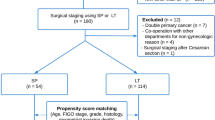Abstract
We directly compared perioperative outcomes and technical features between previous da Vinci Si and the newer Xi robotic platform during total hysterectomy plus salpingo-oophorectomy with or without lymphadenectomy for early-stage endometrial cancer. We retrospectively analyzed147 patients with histological confirmation of endometrial carcinoma stage IA: grade 1–2, 3 and stage IB: grade 1–2 who underwent surgery with da Vinci Si or Xi system between January 2016 and December 2018. Perioperative data, technical features and postoperative complications were considered. 91 patients underwent surgery with the Si system and 56 with the Xi system. Docking time using the Xi system was significantly shorter (p < 0.002), while overall operating time was similar. There were no significant differences in the number of harvested lymph nodes, conversion rate, mean hospital stay, complications, and technical aspects between the two groups. Our study detected similar perioperative outcomes and the trend toward shorter docking and operating time for Xi over Si robot.

Similar content being viewed by others
References
Advincula AP, Song A (2007) The role of robotic surgery in gynecology. Curr Opin Obstet Gynecol 19(4):331–336
Advincula AP, Wang K (2009) Evolving role and current state of robotics in minimally invasive gynecologic surgery. J Minim Invasive Gynecol 16(3):291–301
Shi G, Lu D, Liu Z, Liu D, Zhou X (2014) WITHDRAWN: Robotic assisted surgery for gynaecological cancer. Cochrane Database Syst Rev 2014(12):CD008640. https://doi.org/10.1002/14651858.CD008640
Stefanidis D, Hope WW, Scott DJ (2011) Robotic suturing on the FLS model possesses construct validity, is less physically demanding, and is favored by more surgeons compared with laparoscopy. Surg Endosc 25(7):2141–2146
Simoncini T et al (2016) Robotic-assisted apical lateral suspension for advanced pelvic organ prolapse: surgical technique and perioperative outcomes. Surg Endosc 30(12):5647–5655
Kho RM (2011) Comparison of robotic-assisted laparoscopy versus conventional laparoscopy on skill acquisition and performance. Clin Obstet Gynecol 54(3):376–381
Janda M et al (2010) Quality of life after total laparoscopic hysterectomy versus total abdominal hysterectomy for stage I endometrial cancer (LACE): a randomised trial. Lancet Oncol 11(8):772–780
Scalici J et al (2015) The trend towards minimally invasive surgery (MIS) for endometrial cancer: an ACS-NSQIP evaluation of surgical outcomes. Gynecol Oncol 136(3):512–515
Maenpaa M et al (2015) Implementing robotic surgery to gynecologic oncology: the first 300 operations performed at a tertiary hospital. Acta Obstet Gynecol Scand 94(5):482–488
Lim PC, Kang E, Park DH (2011) A comparative detail analysis of the learning curve and surgical outcome for robotic hysterectomy with lymphadenectomy versus laparoscopic hysterectomy with lymphadenectomy in treatment of endometrial cancer: a case-matched controlled study of the first one hundred twenty two patients. Gynecol Oncol 120(3):413–418
Boggess JF et al (2008) A comparative study of 3 surgical methods for hysterectomy with staging for endometrial cancer: robotic assistance, laparoscopy, laparotomy. Am J Obstet Gynecol 199(4):360e1–360e9
Jorgensen SL et al (2019) Survival after a nationwide introduction of robotic surgery in women with early-stage endometrial cancer: a population-based prospective cohort study. Eur J Cancer 109:1–11
Jorgensen SL et al (2019) New insights into early recovery after robotic surgery for endometrial cancer. Gynecol Oncol 153(2):271–276
Morelli L et al (2017) Use of the new da Vinci Xi(R) during robotic rectal resection for cancer: a pilot matched-case comparison with the da Vinci Si(R). Int J Med Robot 13(1). https://doi.org/10.1002/rcs.1728
Morelli L et al (2018) Robot-assisted total mesorectal excision for rectal cancer: case-matched comparison of short-term surgical and functional outcomes between the da Vinci Xi and Si. Surg Endosc 32(2):589–600
Protyniak B, Jorden J, Farmer R (2018) Multiquadrant robotic colorectal surgery: the da Vinci Xi vs Si comparison. J Robot Surg 12(1):67–74
Patel MN, Aboumohamed A, Hemal A (2015) Does transition from the da Vinci Si to Xi robotic platform impact single-docking technique for robot-assisted laparoscopic nephroureterectomy? BJU Int 116(6):990–994
Abdel Raheem A et al (2017) Da Vinci Xi and Si platforms have equivalent perioperative outcomes during robot-assisted partial nephrectomy: preliminary experience. J Robot Surg 11(1):53–61
Clavien PA et al (2009) The Clavien-Dindo classification of surgical complications: five-year experience. Ann Surg 250(2):187–196
Shafer A, Boggess JF (2008) Robotic-assisted endometrial cancer staging and radical hysterectomy with the da Vinci surgical system. Gynecol Oncol 111(2 Suppl):S18–23
Coronado PJ et al (2012) Comparison of perioperative outcomes and cost of robotic-assisted laparoscopy, laparoscopy and laparotomy for endometrial cancer. Eur J Obstet Gynecol Reprod Biol 165(2):289–294
Corrado G et al (2015) Surgical and oncological outcome of robotic surgery compared to laparoscopic and abdominal surgery in the management of endometrial cancer. Eur J Surg Oncol 41(8):1074–1081
ElSahwi KS et al (2012) Comparison between 155 cases of robotic vs. 150 cases of open surgical staging for endometrial cancer. Gynecol Oncol 124(2):260–264
Wright JD et al (2016) Comparative effectiveness of minimally invasive hysterectomy for endometrial cancer. J Clin Oncol 34(10):1087–1096
Lowe MP et al (2009) A multiinstitutional experience with robotic-assisted hysterectomy with staging for endometrial cancer. Obstet Gynecol 114(2 Pt 1):236–243
Jorgensen SL et al (2019) Nationwide introduction of minimally invasive robotic surgery for early-stage endometrial cancer and its association with severe complications. JAMA Surg 154(6):530–538. https://doi.org/10.1001/jamasurg.2018.5840
Funding
None.
Author information
Authors and Affiliations
Contributions
AG, TS and VC have designed and developed the study and participated in the literature review. Data collection and analysis were performed by EM and CS. The first draft of the manuscript was written by EM and AG, and all authors commented on previous versions of the manuscript. AP, FM, MS and PM have contributed to the manuscript drafting and critically revised the paper. All authors read and approved the final manuscript.
Corresponding author
Ethics declarations
Conflict of interest
Andrea Giannini, Elisa Malacarne, Claudia Sergiampietri, Paolo Mannella, Alessandra Perutelli, Vito Cela, Massimo Stomati, Franca Melfi, and Tommaso Simoncini declare that they have no conflict of interest.
Ethical approval
All procedures performed in studies involving human participants were in accordance with the ethical standards of the institutional and/or national research committee and with the 1964 Helsinki Declaration and its later amendments or comparable ethical standards.
Informed consent
Informed consent was obtained from all individual participants included in the study.
Additional information
Publisher's Note
Springer Nature remains neutral with regard to jurisdictional claims in published maps and institutional affiliations.
Rights and permissions
About this article
Cite this article
Giannini, A., Malacarne, E., Sergiampietri, C. et al. Comparison of perioperative outcomes and technical features using da Vinci Si and Xi robotic platforms for early stages of endometrial cancer. J Robotic Surg 15, 195–201 (2021). https://doi.org/10.1007/s11701-020-01091-6
Received:
Accepted:
Published:
Issue Date:
DOI: https://doi.org/10.1007/s11701-020-01091-6




